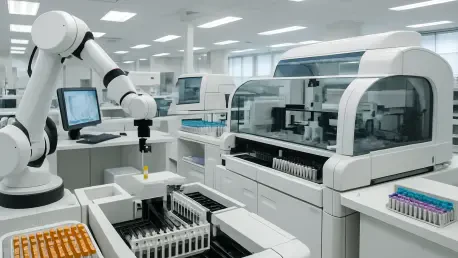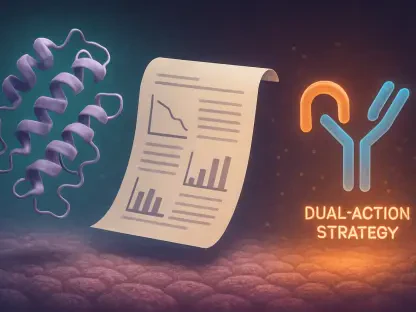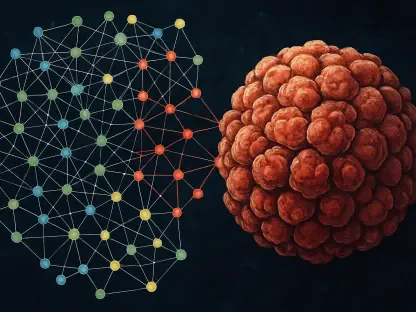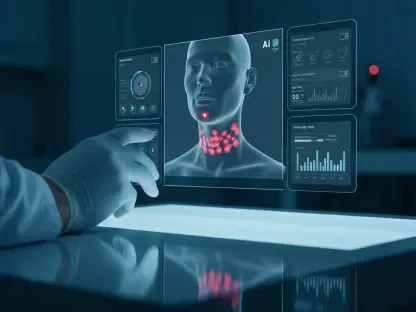The clinical laboratory sector stands on the brink of a monumental shift, propelled by the relentless march of automation and sophisticated data management systems, transforming how diagnostics influence patient care. As healthcare navigates the transition from the Fourth Industrial Revolution (4IR), characterized by digital connectivity and intelligent systems, into the Fifth Industrial Revolution (5IR), which envisions a seamless synergy between artificial intelligence and human expertise, labs are emerging as critical hubs of innovation. This transformation transcends mere technological upgrades; it fundamentally redefines how diagnostics impact broader health ecosystems. Automation has evolved from a tool for repetitive tasks into a strategic force, enhancing precision and responsiveness in ways previously unimaginable. This article delves into the pivotal role of automation in reshaping clinical labs, examining its evolution, the challenges it addresses, the power of data integration, the changing dynamics of the workforce, and the visionary concept of future-ready smart labs poised to lead in the 5IR.
The Rise of Intelligent Automation
The journey of automation in clinical laboratories during the 4IR marks a significant departure from its rudimentary beginnings. Initially confined to handling repetitive, high-volume tasks, automation now encompasses integrated platforms that manage complex workflows with remarkable precision. Modern systems, often powered by machine learning, orchestrate sample handling, perform real-time data analysis, and even propose diagnostic pathways. This evolution means that labs can prioritize urgent cases and detect subtle anomalies without human intervention, vastly improving both efficiency and diagnostic accuracy. Such advancements are not merely incremental; they lay a robust foundation for the adaptive, intelligent systems anticipated in the next industrial wave. As labs embrace these technologies, they position themselves to tackle increasingly intricate clinical demands with a level of responsiveness that was once out of reach, ensuring better patient outcomes and streamlined operations across the board.
Beyond the technological leap, automation addresses critical operational challenges that have long plagued clinical labs. A global shortage of skilled medical technologists, compounded by retiring professionals and difficulties in recruitment, creates a persistent staffing gap. Simultaneously, test volumes are surging due to aging populations and the rise of chronic conditions, while precision medicine demands ever more complex analyses. Automation steps in as a vital solution, scaling laboratory capacity without a proportional increase in labor costs or error rates. Additionally, stringent regulatory frameworks require high levels of standardization and traceability, which automated systems inherently support through consistent processes and detailed documentation. By alleviating these pressures, automation not only sustains lab functionality but also enhances reliability, ensuring compliance with global standards and fostering trust in diagnostic results that directly impact patient care.
Harnessing Data for Strategic Impact
Data integration stands as a cornerstone of automation’s transformative power within the 4IR, redefining how clinical labs operate in a data-rich environment. Laboratories today generate vast and intricate datasets that demand advanced laboratory information systems (LIS) for effective management. These systems do more than organize information; they streamline workflows, drastically reduce manual errors, and enable a level of operational cohesion that was previously unattainable. More importantly, integrated data platforms facilitate proactive healthcare by supporting trend analysis and issuing early intervention alerts. This capability transforms labs from isolated testing facilities into interconnected nodes within a broader healthcare network, where real-time data sharing can drive timely clinical decisions and improve patient outcomes on a systemic level, ultimately enhancing the quality and responsiveness of medical services.
The strategic value of data integration extends far beyond internal lab efficiency, positioning these facilities as active contributors to public health initiatives. By aggregating and analyzing data across diverse sources, modern systems enable labs to identify population-level health trends and support epidemiological modeling. For instance, they can detect emerging disease patterns and trigger rapid responses, a critical function in managing public health crises. This shift reimagines labs as essential partners in a data-driven healthcare ecosystem, where insights derived from integrated systems inform not only individual patient care but also broader strategies for disease prevention and health policy. As data management tools continue to evolve, their role in breaking down silos and fostering collaboration across hospitals and health networks becomes increasingly vital, ensuring that clinical labs contribute meaningfully to a more connected and responsive medical landscape.
Empowering the Workforce and Envisioning Tomorrow
Automation in clinical labs does not signal the obsolescence of human expertise but rather a profound elevation of professional roles. By automating routine, time-consuming tasks such as sample processing and basic data entry, technology frees up laboratorians to focus on higher-value responsibilities like quality assurance, system oversight, and complex data interpretation. This transition, however, necessitates a significant upskilling effort. Proficiency in data literacy and familiarity with AI-driven tools are becoming essential competencies for lab professionals. Continuous training programs are crucial to equip the workforce with these hybrid skills, ensuring they can navigate and leverage the sophisticated systems now integral to lab operations. This evolution underscores a broader trend where technology serves as an enabler, amplifying human capabilities rather than diminishing them, and fostering a more analytical and strategic role for lab staff in healthcare delivery.
Looking to the horizon, the vision of the “smart lab” encapsulates the ultimate promise of automation and data integration in the 5IR. These future labs are imagined as autonomous entities, capable of self-calibrating equipment and predicting maintenance needs with minimal human input. Seamless connectivity across global health networks will allow them to share insights in real time, supporting initiatives ranging from disease surveillance to drug development. Beyond their clinical functions, smart labs are poised to influence healthcare policy through big data analytics, offering evidence-based recommendations that shape systemic improvements. This forward-looking concept redefines labs as dynamic, agile contributors to a holistic health ecosystem, where their strategic importance extends well beyond diagnostics to drive innovation and collaboration on a global scale, heralding a new era of medical advancement.
Reflecting on a Transformative Journey
The sweeping integration of automation and data management in clinical laboratories marks a turning point in healthcare’s evolution through the industrial revolutions. These technologies embed unparalleled intelligence and connectivity into diagnostic workflows, elevating labs from backend operations to central pillars of personalized, responsive medical systems. Challenges such as workforce shortages and rising test complexities are met with scalable solutions, while data integration unlocks new avenues for proactive care. Despite hurdles like proving return on investment and addressing ethical concerns, the path toward autonomous smart labs offers a compelling glimpse into a future of innovation. Moving forward, stakeholders must prioritize investments in training and interoperability to sustain this momentum, ensuring labs continue to shape health outcomes and policy with actionable insights derived from cutting-edge systems.









